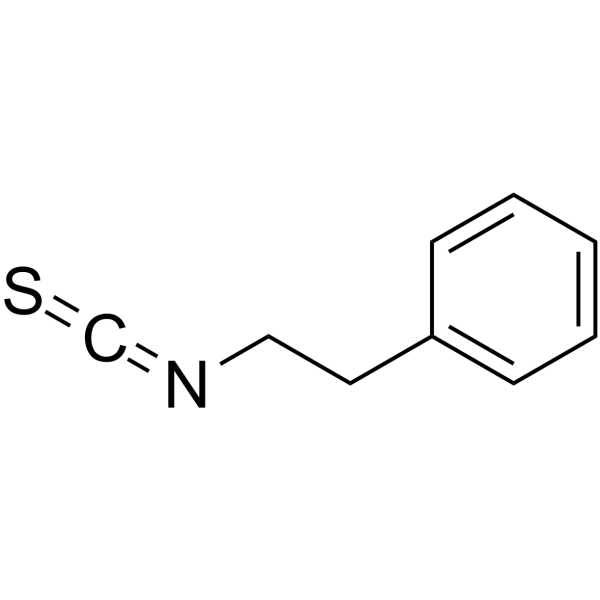Phenylethyl isothiocyanate

Phenylethyl isothiocyanate structure
|
Common Name | Phenylethyl isothiocyanate | ||
|---|---|---|---|---|
| CAS Number | 2257-09-2 | Molecular Weight | 163.23900 | |
| Density | 1.094 g/mL at 25 °C(lit.) | Boiling Point | 75 °C0.25 mm Hg | |
| Molecular Formula | C9H9NS | Melting Point | N/A | |
| MSDS | Chinese USA | Flash Point | >230 °F | |
| Symbol |


GHS07, GHS08 |
Signal Word | Danger | |
|
Phenethyl isothiocyanate, a naturally occurring phytochemical, is an antagonist of the aryl hydrocarbon receptor.
Mol. Nutr. Food. Res. 56(3) , 425-34, (2012) The aryl hydrocarbon (Ah) receptor is a ligand-activated transcription factor that is activated by many carcinogens, and its target gene products play a major role in tumour development, so that antagonists of the Ah receptor represent potential chemopreventi... |
|
|
Prediction and identification of drug interactions with the human ATP-binding cassette transporter multidrug-resistance associated protein 2 (MRP2; ABCC2).
J. Med. Chem. 51 , 3275-87, (2008) The chemical space of registered oral drugs was explored for inhibitors of the human multidrug-resistance associated protein 2 (MRP2; ABCC2), using a data set of 191 structurally diverse drugs and drug-like compounds. The data set included a new reference set... |
|
|
In vitro metabolic conversion of the organic breakdown products of glucosinolate to goitrogenic thiocyanate anion.
J. Sci. Food Agric. 95 , 2244-51, (2015) Glucosinolates are abundant in Brassicaceae vegetables, and they are degraded into various organic breakdown products (BPs) (R-CN, -NCS and -SCN) by myrosinase when plant tissues are damaged. This study was designed to investigate whether these BPs could be b... |
|
|
ID helix-loop-helix proteins as determinants of cell survival in B-cell chronic lymphocytic leukemia cells in vitro.
Mol. Cancer 14 , 30, (2015) Members of the inhibitor of DNA-binding (ID) family of helix-loop-helix proteins have been causally implicated in the pathogenesis of several types of B-cell lineage malignancy, either on the basis of mutation or by altered expression. B-cell chronic lymphocy... |
|
|
Glutathionyl-hydroquinone reductases from poplar are plastidial proteins that deglutathionylate both reduced and oxidized glutathionylated quinones.
FEBS Lett. 589(1) , 37-44, (2014) Glutathionyl-hydroquinone reductases (GHRs) catalyze the deglutathionylation of quinones via a catalytic cysteine. The two GHR genes in the Populus trichocarpa genome, Pt-GHR1 and Pt-GHR2, are primarily expressed in reproductive organs. Both proteins are loca... |
|
|
Cytochrome p450 enzymes mechanism based inhibitors: common sub-structures and reactivity.
Curr. Drug Metab. 6 , 413-54, (2005) The inhibition of human cytochrome P450s (CYPs) is one of the most common mechanisms which can lead to drug-drug interactions. The inhibition of CYPs can be reversible (competitive or non-competitive) or irreversible. Irreversible inhibition usually derives f... |
|
|
Transient receptor potential ankyrin 1 (TRPA1) channel as emerging target for novel analgesics and anti-inflammatory agents.
J. Med. Chem. 53 , 5085-107, (2010)
|
|
|
Chemopreventive and anti-angiogenic effects of dietary phenethyl isothiocyanate in an N-methyl nitrosourea-induced breast cancer animal model.
Biopharm. Drug Dispos. 34(2) , 98-106, (2013) The effect of phenethyl isothiocyanate (PEITC), a component of cruciferous vegetables, on the initiation and progression of cancer was investigated in a chemically induced estrogen-dependent breast cancer model. Breast cancer was induced in female Sprague Daw... |
|
|
Phenethyl isothiocyanate upregulates death receptors 4 and 5 and inhibits proliferation in human cancer stem-like cells.
BMC Cancer 14 , 591, (2014) The cytokine TRAIL (tumor necrotic factor-related apoptosis-inducing ligand) selectively induces apoptosis in cancer cells, but cancer stem cells (CSCs) that contribute to cancer-recurrence are frequently TRAIL-resistant. Here we examined hitherto unknown eff... |
|
|
Antibacterial activity and mode of action of selected glucosinolate hydrolysis products against bacterial pathogens.
J. Food Sci. Technol. 52 , 4737-48, (2015) Plants contain numerous components that are important sources of new bioactive molecules with antimicrobial properties. Isothiocyanates (ITCs) are plant secondary metabolites found in cruciferous vegetables that are arising as promising antimicrobial agents i... |